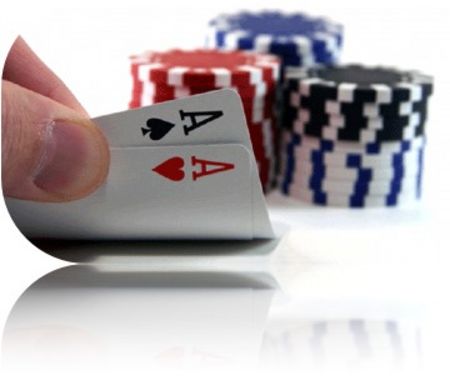The Blinds

Advanced players can sometimes raise with a few more hands out of the blinds in
an unraised pot. These hands might include TT, 99, 88, AJs, AJ, and KQs, as well
as other suited connectors and small pairs to vary your game. These raises are
dependent on many factors: the number of callers, position of callers, skill level of
your opponents, and your table image. For example, if there are many callers in the
hand, then raising with a hand like 88 or KQs could be profitable since you are
getting good implied odds should you hit a big flop. You might raise with AJ against
a middle caller and the small blind simply because you feel you have the best hand.
However, be careful not to try these kinds of plays too often.
Raising from the blinds decreases your pot odds. For example, there are three
callers in a $10-$20 game. From the small blind, you would need to pay $5 to call,
so you are getting 9 to 1 pot odds with $45 in the pot. You can play many hands
with 9 to 1 pot odds. If you raise, you are paying $15 to win a pot of $75, assuming
everyone calls except the big blind. In this case your pot odds have decreased to 6
to 1. You have decreased your pot odds, while at the same time you have
decreased your chances of winning the pot since your opponents are less likely to
fold on the flop or turn with a bigger pot You also must overcome acting first on
every belling round.
Note the difference: 9 to 1 pot odds with a better chance of winning the pot versus 6
to 1 pot odds and a decreased chance of winning. You should usually only raise
with the premium hands mat are strong enough to compensate for acting first on
every betting round with decreased pot odds. When you raise in middle position or
late position, it is true your pot odds decrease also, but your odds of winning the pot
have increased as you are most likely minimizing the field as well as gaining
position over your opponents.
Raised Pots
You can reraise with more hands from the blinds than indicated in the previous
chapter when the raise comes from a lone player in a blind-stealing position. You
sometimes need to "defend" your blinds against those aggressive opponents who
try to steal your blinds too often with weak hands. Hands to consider a reraise
include any pair 66 or higher, Ax, and any KT or higher. You don't always have to
reraise with hands like A6 or KT, but it is important to sometimes be aggressive
against your opponent. From the big blind you can also call against a late raiser
with more hands than indicated in the previous chapter. Hands like small pairs and
A7 through A2 are borderline decisions mainly dependent on the type of opponent
you are against.
When you are in the small blind, you often should cither reraise or fold against a
lone raiser from any position. Reraising helps to drive out the big blind to isolate
you against the lone raiser.
When heads up from the big blind, one strategy against an aggressive raiser is just
call with your premium hands such as AA, KK, QQ, AKs, and AK. This works best
against an early or middle position raiser in order to disguise you hand when heads
up. You are sacrificing the preflop remise hoping to gain more bets later in the
hand. Sometimes reraising from the blinds will cause your opponents to back off
their hands, so just calling can sometimes be an effective strategy when heads up
to add deception to your game and possibly win more bets.
Calling raises from the blinds is often a difficult decision. You are out of position
playing against an opponent who has showed strength, yet you are receiving good
pot odds on your bet. Often, your borderline decisions are dependent on the type of
opponents you are against. If you are against opponents who tend to play poorly
after the flop, you can call with a few more hands than indicated in the previous
chapter. Calling is more profitable against opponents who will pay you off nicely if
you hit your hand. Against opponents who play well sifter the flop, you should
probably fold the borderline hands.
Small Blind vs. Big Blind

Small blind vs. big blind scenarios occur much more frequently in the high-limit
games than the low-limit games since high-limit games tend to be tighter. They also
occur a lot in short-handed games. As discussed in the previous chapter, many live
players don't face these situations very often since they can "chop" but it is
essential to learn good strategies for these situations on the Internet.
Let's look at some possible strategies. Let's assume you are in the small blind and
you have the rare luxury of having a rock in the big blind. One option is to raise
every hand! In a $20-$40 game, you are paying $30 to win the $30 already in the
pot. If the big blind folds half the time, you will break even just on your raise and
you will win money those times that you hit a big hand on the flop.
What if you are in the big blind and somebody in the small blind tries this strategy
against you. An extreme counter strategy would be to reraise every time! Assuming
the small blind raises every hand, you will have equal hands on average. By
reraising every tune, you now have three small bets in the pot while you have the
best position and get to act last on every betting round. For this same reason,
raising every time is also a possible strategy against a small blind who calls every
time.
Of course, this is an extreme counter strategy. If a small blind attacked me every
hand, I would probably reraise with about 60% to 70% of my hands. Although these
two scenarios are very rare, the reason I show them here is to present the wide
spectrum of strategies possible given the type of opponent you are against.
One other thing to consider is how your opponent plays after the flop. Some
opponents make the mistake of folding too often on the flop. In this case, you want
to play more hands in both the small blind and big blind and should consider raising
more hands. For example, there is $40 in the pot in a $20-$40 game if you call from
the small blind and the big blind doesn't raise. If you come out betting every flop,
you are getting 2 to 1 odds on your bet. If your opponent folds more than 1 out of 3
times, you make an immediate profit on your bet!
Of course, you will also win some money for those times that he calls and you have
the best hand. Note how these odds are even better if you raised preflop. Now you
would be getting 4 to 1 pot odds on your flop bet and would make an immediate
profit if your opponent folds more than 1 in 5 times!
For these reasons, starting hand guidelines for small blind versus big blind
situations are very dependent on your opponent. If you can play many hands
without a showdown, you can raise practically every hand and bet out every flop!
Observe your opponents and adjust your strategies accordingly.
Review

Advanced players can play a few more borderline hands and add some deceptive
plays that have an expected value of close to break even or are just slightly
profitable. Beginning players will probably lose money playing these additional
hands.
Early Position
-
Consider slowplaying your premium hands AA, KK, and AKs in a tight
aggressive game.
- Consider raising with medium pairs and a hand like AJ in a tight game.
- Consider calling first in with Axs, KJs, and QJs.
- Consider calling with a few more speculative hands like 66 and QTs when
there has already been one or two callers
- Rarely make a deceptive raise from early position on the internet with a hand
like 98s
Middle Position
-
Consider raising first in with any hand that you would call if you feel you have
a reasonable chance of either stealing the blinds or control ling the flop.
- Sometimes even consider raising some borderline hands against one limper
if the conditions are right.
-
Your first consideration in a raised pot is the position of the raiser.
Late Position
-
Consider raising with many hands when first in, especially if the blind are
tight or play poorly after the flop.
- Raise fairly often against a limper who calls from middle or late position.
- Against a lone raiser, you should generally either reraise or fold.
- Against several strong opponents, consider raising with your medium pairs.
Generally just call against weak opponents.
The Blinds
-
Generally only raise with premium hands from the blinds since you are
decreasing your pot odds while having to act first on every betting round.
Consider an occasional raise with a borderline hand given the right
conditions to add some deception to your game.
- Consider reraising against a lone late raiser to defend your blinds.
- The small blind should generally either reraise or fold against a lone raiser
from any position.
- Consider slowplaying your premium hands from the big blind against an
aggressive lone raiser
- Starting hand guidelines for small blind versus big blind situations are very
dependent on your opponent. Generally you should play aggressively,
especially if your opponent plays too tight.
NEXT...The Flop

